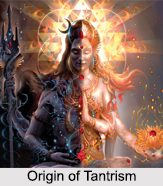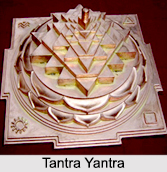 Origin of Tantrism has several disputes. Some historians are of the view that the Pre-Aryan Indians could have been the originators, others attribute it to the tradition of ancient people. Historically, it dates back to the time of the rise of Buddhism as the later Buddhists adopted some of the Tantric symbols. Today, the tradition of Tantrism is practiced in the far north-east regions, amid the jungles and foothills of the Himalayas. Tantrism has been influenced by many historic trends in the 5th century CE to evolve as esoteric circles.
Origin of Tantrism has several disputes. Some historians are of the view that the Pre-Aryan Indians could have been the originators, others attribute it to the tradition of ancient people. Historically, it dates back to the time of the rise of Buddhism as the later Buddhists adopted some of the Tantric symbols. Today, the tradition of Tantrism is practiced in the far north-east regions, amid the jungles and foothills of the Himalayas. Tantrism has been influenced by many historic trends in the 5th century CE to evolve as esoteric circles.
Tantrism, today is a method of conquering transcendent powers and realizing oneness with the highest principle by Yogic rituals to achieve other supernormal goals. Tantrism also exerted considerable influence on Jainism. In a narrower sense Tantrism refers to doctrines and practices embodied in specific Shaiva and Shakta texts called Tantras.
History of Tantrism
History of Tantrism is the history of the interaction between the two strands of practice and practitioners, whose clienteles, comprise commoners and political elites. The word Tantra means what extends knowledge. Some scholars argue that Tantra constitutes the continuation of the original Indian aboriginal tradition which predates the coming of the Indo-European Aryan invaders and their Vedic religion. Tantra appears in provinces that had not been strongly influenced by the Vedas for example the Northwest, West Bengal and the South in the 4th century. Within a few centuries it had attained pan-Indian influence.
The origin of Tantrism traces its roots to the magic and fertility cults of pre- or non-Aryan India. It is believed that Tantrism arose on the edges of Aryan influence in the eastern and northeastern part of India and Bengal. In Hinduism, Tantra pervades the theistic traditions of Shaivism, Shaktism, and Vais??avism.
Tantra in Vedas
Kesin hymn in Rig Veda admires "wild loner" who is carrying fire, poison, heaven and earth within himself in the form of different human emotions. This describes the ecstasy or state of consciousness experienced by sages or tantric practitioners. Upanishads refer to nadis to describe how the Atman or spiritual body is connected with physical body and interdependent through energy carried in the arteries when one is awake or sleeping. These vedic concepts later identified as nadis and chakras were found in Tantra.
Tantra in Buddhism
Tantra before Buddhism had proto-tantric elements which might have influenced the development of Buddhist Tantrism. This includes magical chants found in early Buddhist texts as and some Mahayana sutras. Several Mahayana sutras mentioned the use of mantras as a central feature of tantric practice. Worshiping deities in meditation was a key element in tantric practice before Buddhism which was later found in Mahayana sutras. A series of artwork showing Buddhist and Hindu monks holding skulls are excavated from Gandhara, modern-day Pakistan. Tapping skulls has been a popular practice in Tantrism and these artworks dating back to 1st century CE is an evidence of the existence of tantrism during that period.
 Tantra in Shaktism
Tantra in Shaktism
Shaktism is about worshiping mother goddess in her most terrifying form as Shakti. The goddess is generally Devi Durga or Parvati annihilating demons representing the triumph of good over evil. Tantrism is related to practices to seek the spiritual energy and ultimately release it in the form of truth. Both the doctrines are based on a strong force or energy and it existed since 1st millennium. Many temples of great goddesses representing Shaktism have been discovered from that time. The 7th century novel “Kadambariâ€, written by Banabhatta mentions about Tantrism and tantric practices more vividly.
Tantra in Shaivism
Shaivism seem to have been involved in the initial development of Tantrism, specifically the transgressive elements. It is believed that the Pashupatas, one group of Shaivites, practiced a form of spirituality in shocking and disreputable behavior such as dancing, singing, and smearing themselves with ashes. This was later found in a tantric context. Early Tantric practices were also associated with Bhairava and the Kapalikas, two groups of Shaivites.
Tantra in Vaishnavism
Vaishnavism refers to Lord Vishnu as the supreme deity and the manifestation of power and positive energy. It is this energy that is most sought after in Tantric practices. It is believed that Vishu as Krishna and Radha symbolizes two strong forces of nature somewhat similar to form of Shiva and Shakti. According to the Vaishnavas, Krishna and Radha are manifestations of absolute reality. The concept of Shiva-Shakti in Tantra has supposedly inspired the concept of Krishna-Radha.
Types of Tantrism
A number of independent branches developed like the;
•Mahayana Buddhist Tantrism,
•Shaivite Tantrism,
•Natha Tantrism,
•Shakta Tantra,
•Cosmological Tantrism,
•Jain Tantrism and
•Vaishnava Tantrism.
Rituals in Tantrism
The rites pertaining to "homa" or "Yajna" is common to most Tantric traditions are direct heirs of the Vedic homa sacrifices, whereas certain elements of Tibetan Buddhist Tantra clearly draw on both Iranian and indigenous traditions. The multiple goddesses called yoginis, dakinis and "vixen" spirits are found in every Tantric tradition. In the Indian context, cults of multiple goddesses were present in the nymphs, female fairies, Mothers and female seizers, who were generally propitiated with animal sacrifices and early forms of devotional worship. These goddesses were mainstream, which is further proven by the fact that such female seizers were depicted on coins and sculpture of the Kushana and Gupta-age.
However it can be ascertained that Tantra emerged out of the South Asian elite and popular mainstream sometime in the middle of the 1st millennium century. The founders of every Tantric tradition either trace their guru-disciple lineage back to an Indian source or are deemed to be incarnations of bodhisattvas of Indian origin. The multi-headed and multi-armed deities and their burgeoning families are Indian or traceable to Indian models. Much of Tantric legend revolves around the Indian "shamanic culture heroes". The language of Tantra remains the Sanskrit of medieval Indian Hinduism and Buddhism. The Tantric practice which is an important element of Tantra is of Indian origin.




















